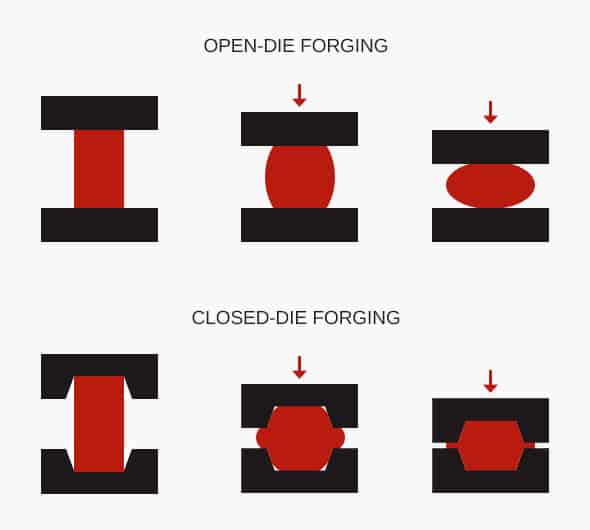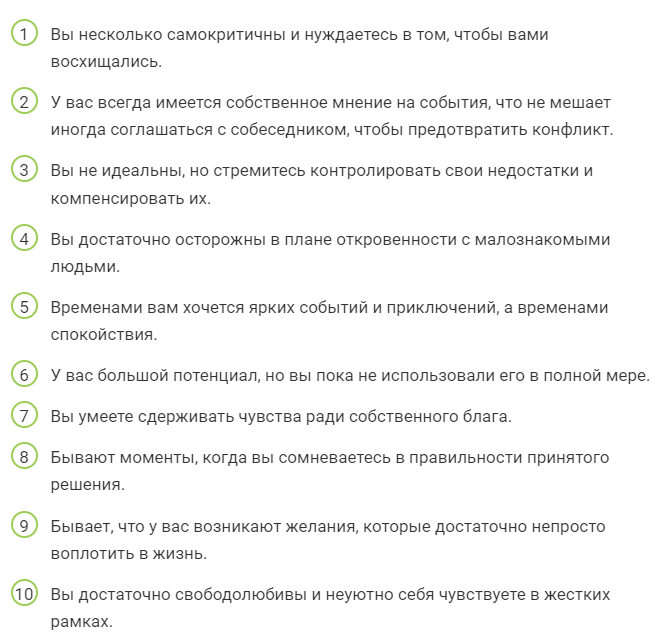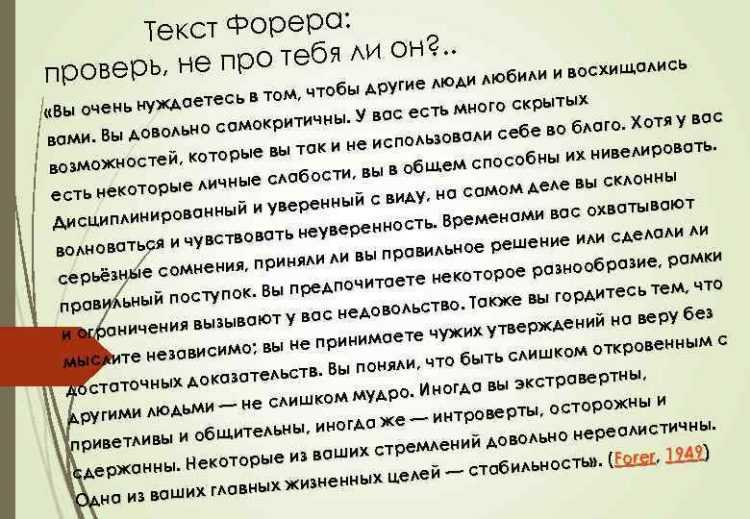Using the Barnum Effect with quizzes
At this point, it’s clear that people will accept general statements and apply a high degree of accuracy to it after answering questions about themselves.
There are a few things to take into consideration to make it work successfully with quiz outcomes.
Barnum Statements
Barnum statements are assertions that are vague and general but seem to be specific to an individual. For example, you can tell someone “at times, you have a strong sexual appetite.”
Well duh, almost everyone gets turned on every now and again but under the right circumstances, it seems personal and accurate.
They’re commonly used by psychics and mediums to put their subjects at ease and make them more receptive to statements that follow.
We’ll use it in a slightly different way.
When crafting your quiz outcomes, it’s important to make them vague enough to apply to a large group of people. At the same time, you want to phrase them in a way that’s personal and relates to the answers they gave.
It’s necessary to prime them with the title of the quiz and the questions you ask.

In the above image, the title itself primes me for a comparison to a game of thrones character. The quiz goes on to ask me questions about how I’d behave in certain scenarios which reinforces my belief of an accurate assessment.
Pollyanna principle
To get the most mileage out of your quiz outcomes and increase the believability, a little flattery is in order.
The Pollyanna Principle is the tendency for people to remember positive or pleasant items more often and more accurately than unpleasant ones.
This makes sense. Why would you allocate mental bandwidth to an argument or unpleasant experience? On the other hand, we cherish moments when we’re happy or pleased.
Your quiz outcomes can tap into the Pollyanna principle by adding a few positive Barnum statements.
For example, in the Game of Thrones quiz, I got Jon Snow.
Using Barnum Statements and the Pollyanna principle, a possible outcome could mention “When it matters enough to you, you become a fighter, just like Jon, you’re able to turn around situations that would sink others.
It’s a generally positive statement that could apply to everyone but seems unique because I just took a personality assessment.
The wording of the description itself.
This refers to how often you use positive statements vs negative statements. The more positive statements you use, the more likely someone is to take the assessment to heart.
That doesn’t mean you shouldn’t use any negative descriptions or statements. They have their place and when used sparingly, it increases the likelihood the receiver will believe what you say.
Authority and honesty of the assessor
This is a major factor in determining whether or not someone will accept your outcome. Are you in a position to give advice on the topic? Are you credible in your niche?
For example, a fitness blogger could set up a quiz about body types and effectively sell the outcomes. If they put up a quiz about online income then it may not go over as well.
This is an extreme example but you should keep in mind that your quiz and outcomes should focus on your core competency. An SEO expert shouldn’t make a quiz about lead generation or CRO. It’s tangentially related but not quite their core competency.
Barnum Statements Examples & Implications
“You are a very logical person. You tend to think things through before acting. You enjoy having a structure in your life, and you like knowing exactly what’s going to happen next and when. You’re not particularly adventurous and you prefer keeping things nice and predictable.”
On the surface, this statement may seem like it applies specifically to you but it doesn’t actually say anything about you at all. It could apply to anyone who fits that description.
Personality tests like the Myers-Briggs Type Indicator (MBTI) are designed to categorize people according to their traits on a spectrum, from introverted/extroverted to thinking/feeling, among other factors. The test is designed so that most people score in the middle on all traits.
That means that when a person reads their results and finds out they are an INFJ or ENFP or any of the 16 possible combinations, they think that is an accurate description of who they are. However, since most people have a middle score on each trait, the results could actually apply to most anyone.
On social media
Social media has become a place where people can post information about themselves that makes them appear attractive to others. Statements such as “You are a very colorful person, you can be highly critical of yourself, you feel that others are watching you and judging you all the time, you tend to avoid conflict.”
People are likely to believe the information posted about them because it speaks to their ideal self-image. This tendency can be used in marketing by companies when describing their products and services, which are then perceived as being more attractive than they actually are.
On social media websites like Facebook or Twitter, you may often be asked to fill out the information about yourself when creating an account so that they can personalize advertisements and content suggestions based on what they think you will like.
While this information may not be as specific as your birthdate or home address, it’s still enough for advertisers to target you with ads that seem like they’re meant just for you.
For example, on intelligence tests and online quizzes, people are sometimes asked to rate the accuracy of a statement like this one: “You often find yourself feeling misunderstood by others.” Almost everyone rates this as true, and it’s hard to imagine anyone rating it as false, because who doesn’t feel misunderstood from time to time? This is an example of the Barnum effect in action.
On astrology
In astrology, for example, people tend to believe that the vague predictions in horoscopes are accurate because it’s easy to identify with ambiguous statements about who you are and how you behave. Because of the Barnum Effect, astrology and other forms of pseudo-psychology tend to be popular even though there’s no real evidence of any psychic ability. Many people are willing to simply accept that these methods work because they want them to work and because they accept personal descriptions as proof that these things are true.
On palm reading and horoscopes
In palm reading, vague statements about your past and future such as “you have been through difficult times” still seem like they apply specifically to you because they’re so universal and broad. Also, Barnum statements are most commonly used by fortune-tellers and palm readers, who can make a prediction seem personal and meaningful to any individual, regardless of whether the statement is actually true or not.
For example, if a palm reader says “You’re very independent” or “You have an old soul,” these statements could apply to anyone. However, they may be interpreted by an individual as meaning something specific about him or herself.
The Barnum effect and exploiting cognitive biases
It’s important to note that businesses using the Barnum effect are not preying on people for monetary gain.
Instead, they are simply tapping into a tendency for consumers to filter the extraordinary amount of information they are bombarded with daily.
Cognitive biases help this filtering because invariably, consumers only respond to personally meaningful information.
Or, in the case of the Barnum effect, information that flatters or validates.
Businesses should always remember that these biases occur with or without the presence of marketing.
There is nothing to be lost by marketing agencies telling consumers what they want to hear, which makes them feel more valued as a result.
Практические проявления эффекта Барнума
В жизни эффект Барнума встречается часто. Процветает среди специалистов по всякого рода гаданиям. Почему бы не помутить кофейную гущу или не раскинуть карты? А потом с умным видом поведать, что ждет впереди. Впечатлительная душа воспримет с верой и за общие фразы о светлом будущем неплохо заплатит. Таких охотников легкого заработка — магов, хиромантов, астрологов, нумерологов, других «знатоков» человеческих душ — расплодилось невероятное количество. Вряд ли всех представителей оккультных наук следует считать шарлатанами. Среди них много честных людей, искренне пытающихся объяснить природу человека и его место в мире. Однако много и проходимцев, довольно удачно использующих эффект Барнума-Форера, чтобы обогатиться за счет слишком доверчивых или убитых своими несчастьями людей. За примерами ходить далеко не надобно.
Цирк Барнума собирал аншлаги, люди толпами шли посмотреть на необычных людей. Например, у него выступал некий Фёдор Евтищев из Санкт-Петербурга. Лицо у него густо заросло щетиной, отчего имело сходство с собачьей мордой. Он якобы не умел разговаривать, а только рычал и лаял. Или фиджийская русалка — существо с головой обезьяны, пришитой к туловищу большой морской рыбы. На такую невидаль люди валили валом, верили в реальность такого чуда и платили за это большие деньги.
Такие цирковые представления облегчали карманы добропорядочных американцев, но шли они на это сознательно и охотно. Пикантные штучки Короля Веселого Надувательства только веселили людей. Однако шарлатаны смекнули, что на здоровье можно хорошо заработать. Если человек легко внушаемый, он легко поддается словесным манипуляциям.
За примерами эффекта Барнума в наше время ходить далеко не нужно. Вспоминается сеанс одного народного целителя. Реклама вещала, что он излечивает от 101 болезни, заряжает воду, лечит по своей фотографии. Стоили они недешево и были нарасхват. В Доме культуры яблоку негде было упасть, так много собралось больных. Кто-то привозил в инвалидных колясках парализованных детей, своих близких. Край сцены был уставлен трехлитровыми бутылками с водой.
Люди завороженно смотрели на экстрасенса, он казался последней надеждой, соломинкой, за которую хватается утопающий, чтобы спасти свою жизнь или своих родных. Они ему верили, что поможет избавиться от недуга, перед которым спасовали врачи. А тот уверенно расхаживал по сцене, объясняя суть своего лечения, гарантировал исцеление от рака, церебрального паралича, других тяжких заболеваний. И походя обмолвился, что его метод не действует на тех, кто пришел на сеанс без билета.
Вот вся суть такого «народного» лечения. Главное для этаких целителей — деньги. О каком сострадании к людям тут можно вести речь? Христос излечивал страждущих бесплатно, а такие «врачи» наживаются на людской беде. Болезнь человека для них — доходный промысел, способ безбедного существования. На такую корысть, к сожалению, нередко работает эффект Барнума.
Важно знать! Эффект Барнума — это один из способов выкачивания денег из слишком любознательных и доверчивых людей или таких, кто в силу различных причин попал в затруднительное положение
- Читайте про крем-гель Virgin Star для сужения влагалища
- Крем-воск Здоров для омоложения и питания кожи лица
Суть и история открытия эффекта
Финеас Барнум
Барнум
Об эффекте Барнума говорят в том случае, когда человек уверен в правильности описания своей личности и характера, хотя формулировки являются общими и статистически вероятными. При этом должны соблюдаться такие правила:
- в описании используются туманные, абстрактные формулировки;
- характеристики должны быть позитивными;
- содержать те личностные качества, которые применимы к большинству людей;
- человек должен быть уверен в авторитетности источника описания;
- у человека также должна быть уверенность, что характеристика составлена индивидуально для него (исключение — гороскопы по знакам зодиака, характеристика имени и тому подобное).
В середине 20-го века психологом Бертрамом Форером был проведен психологический эксперимент: студентам раздали тесты, результаты которых якобы раскрывали их личности. При этом вместо индивидуальных психологических характеристик в качестве результатов тестирования Б.Форер дал студентам один и тот же текст из гороскопа с расплывчатыми формулировками. Студенты должны были ему проставить оценку по 5-ти балльной системе, исходя из личных представлений о самих себе. В итоге средний балл был 4,26.
В тексте использовались общие описания, которые можно было применить практически к любому человеку. Они были позитивны, характеризовали студента как неординарную личность. К тому же авторитет преподавателя в глазах аудитории был высок. Здесь еще имел место эффект доктора Фокса: студенты высоко оценили результаты теста, исходя из позитивного отношения к исследователю.
Все эти факторы и повлияли на высокую оценку ненаучного описания личности, взятого из гороскопа. Независимые исследователи позднее неоднократно проводили подобные эксперименты и всегда получали те же результаты.
Еще одним парадоксом эффекта Барнума является то, что своим названием он обязан не официальному автору эксперимента Б.Фореру, а артисту цирка (как сейчас бы его называли шоумену) Финеасу Барнуму, жившему в 19 веке. Он был известен своими мистификациями и психологическими манипуляциями, за что и получил прозвище «Король Веселого Надувательства».
Examples of the Barnum Effect
Some examples of the Barnum effect include horoscopes, fortune-telling, personality tests, and “cold readings,” which are when someone makes vague statements about a person and finds ways to credit their accuracy when the person agrees.
- A horoscope will include a prediction for each sign of the zodiac that can apply to anyone who reads it; however, people tend to believe it is specific advice based on their individual sign.
- Fortune cookies have become a tradition at Chinese restaurants in the United States, but they aren’t actually used in China. The messages inside are very broad and simple, but they can apply to anyone who reads them for example, “You will meet someone new soon,” “Your life will be full of good things,” or “You have a great future ahead of you.”
- Personality tests such as the infamous Myers-Briggs test are also often subject to the Barnum effect because they are written in such general terms that they can apply to just about anyone however, people tend to believe that the results are specific and accurate for them.
Key Highlights of the “Barnum Effect”:
- Definition: The Barnum Effect is a cognitive bias where individuals believe that general information, which applies to many people, is personalized for them.
- Examples: Daily horoscopes and personalized recommendations on platforms like Facebook, Spotify, and Netflix are classic instances of the Barnum Effect.
- “Fallacy of Personal Validation”: Psychologist Bertram R. Forer termed the Barnum Effect as the “fallacy of personal validation,” as people trust and accept compliments even if they are broadly applicable.
- Business Benefits: Businesses can capitalize on the Barnum Effect to enhance customer engagement, brand loyalty, and retention by making customers feel personally connected to the brand.
-
Marketing Implementation:
- Production recommendations and curated lists, as seen on Amazon.
- Targeted banner advertisements on product websites.
- Persuasive sales copy addressing consumers’ specific pain points.
- Ethical Use: Businesses using the Barnum Effect are not exploiting customers; rather, they tap into cognitive biases that consumers exhibit naturally to filter information and seek validation.
- Consumer Tendency: Consumers seek personalized and meaningful information, leading to the utilization of cognitive biases like the Barnum Effect for effective marketing.
About The Site
This site is for generalized informational purposes only and the views found here should never be considered specific investment advice.
Visitors should always do their own homework and consult, as needed, with a personal financial adviser who understands their specific individual circumstances before taking action on any particular investing idea. What makes sense as an investment in one set of individual circumstances may not in another.
Opinions found on the blog are just that, opinions, could easily be wrong in all kinds of ways, and should never be considered advice that is specific in nature. Stocks and other investment vehicles are inherently filled with risks including the possibility, or even likelihood, of permanent loss of capital. Past performance, of course, should not be considered indicative of future results. Due diligence is necessary.
The content found here shall not be taken as a recommendation to buy or sell any security or to participate in any particular investment strategy. Again, that necessarily comes down to individual circumstances. So, in other words, there is no personal financial adviser here, just some opinions and views. These opinion and views are subject to change at any time and, since they are not individualized in any way, consultation with an investment professional and doing one’s own rigorous research/analysis before making any investment decisions is essential.
All posts are simply presented as one view on investing and some related topics though never specific recommendations. An investor should always get help from an investment professional if they feel they need it and, most importantly, before mistakes are made. Ultimately, the actions of individual investors, whether they happen to be a visitor to this site or not, are their own responsibility (and, if applicable, so are the associated losses). While there will always be a very real risk of permanent capital loss in investing, those who know their own limits and ask for professional advice when they require it can improve their chances substantially. Investors should never buy or sell a security based upon what they’ve read on any blog.
Information on this site is believed to be accurate yet may include errors or omissions and is not guaranteed. The site is also never a solicitation or offer to buy or sell any securities.
Posts on this blog do not offer opinions on the future price action of specific stocks or the capital markets as a whole. Instead, the focus is sound investing principles but never predictions or recommendations. It’s understanding productive assets and their likely intrinsic value; how they may or may not compound in intrinsic worth over a long time horizon. It’s about investing with a comfortable margin of safety. It’s NOT about speculating on price action. In the near-term, or even longer, the market price of an asset can do just about anything.
A temperamental market pretty much assures it.
Those with a long investing horizon, it’s worth noting, actually benefit from lower stock prices in the near-term (though not many market participants seem willing to put this truism to effective use). Those who attempt to profit primarily via speculating on short-term price action likely won’t find this way of thinking to be of much interest.
The bottom line: This site does not provide individual investment advice of any kind and the blog posts found here are never a recommendation to buy or sell anything. Visitors should start with the assumption that the ideas found here are not good ones and do their own homework (or get individualized help from an investment professional) before taking ANY action.
Otherwise, hopefully some occasionally find the site worthwhile.
Открытая штамповка по сравнению с Ковка в закрытых штампах
Вы сможете понять, что означают процессы, взглянув только на термины.

Но для людей, которые не очень хорошо в этом разбираются, вот как их можно отличить.
При свободной штамповке металлическая деталь или заготовка помещается между несколькими штампами. Процедура выполняется без полного закрытия материала.
С другой стороны, штамповка в закрытых штампах сжимает заготовку или кусок металла под высоким давлением, чтобы заполнить необходимую форму или форму.
Частью их различий является их процесс. Они не используют одну и ту же процедуру в отношении того, как они завершаются и достигаются. После того, как процесс штамповки в закрытых штампах завершен, он практически не требует механической обработки из-за высоких показателей точности.
После ковки в открытых штампах на противоположном конце каната потребуются высокоточные процессы механической обработки для достижения желаемой формы.
В чём суть эксперимента Барнума?
В 1948 году профессор Бертрам Форер провёл любопытный эксперимент, который впоследствии получил название «эксперимент Барнума-Форера». Суть этого эксперимента заключалась в следующем: профессор дал своим студентам тест, по результатам которого можно было бы оценить их личностные качества.
Однако вместо обработки результатов и объективного оценивания способностей каждого студента он напечатал характеристику, взятую им из гороскопа. Копии этой характеристики профессор раздал студентов и провёл ещё один опрос, чтобы уточнить, согласны ли они с результатами оценивания. Как ни удивительно, но будущие психологи среагировали на этот трюк также, как реагировали на гороскопы обыватели. Они оценили объективность теста в 4,26 балла по пятибалльной шкале.
После того как профессор Форер убедился в том, что эффект Барнума в психологии встречается повсеместно, он стал проводить свой эксперимент ежегодно. По его словам, участие в этом эксперименте было лучшей наукой для будущих психологов, так как помогало им научиться разделять правду и вымысел. Исследование Форера позволило углубить и расширить познания об эффекте Барнума, а сам эффект Барнума стали называть «эффект Форера-Барнума».
Если вам интересно, вы можете изучить ту характеристику, которую большинство студентов профессора Форера посчитали подходящей под описание своего характера. Она выглядела примерно так (с учётом многократных правок и перевода с английского языка):
«Вы достаточно самокритичный человек, испытывающий потребность в любви и восхищении со стороны окружающих. Ваши многочисленные таланты преимущественно не реализованы. Свойственные вам слабости и недостатки вы умеете преодолевать. Однако, несмотря на внешнюю уверенность в себе и организованность, вы часто переживаете и комплексуете. Иногда вы сомневаетесь в правильности своих поступков.
Предметом вашей гордости является независимое мышление. Вы стараетесь выходить за рамки общепринятого мнения и объективно оценивать реальность. Попытки ограничить вас в этом вызывают у вас негодование.
Вы знаете, что не стоит излишне доверять людям. Иногда вы расположены к общению, иногда – наоборот, замкнуты и сдержаны. Ваши цели частично недостижимы. Впрочем, среди них главенствующую роль играет стремление к стабильности».
В дальнейшем эксперимент Форера был доработан. Студентам давали две характеристики. Одна из них была настоящей, сделанной на основе результатов пройденного ранее психологического теста. Вторая была доработанной характеристикой Форера. Студентам предлагали выбрать ту характеристику, которая, по их мнению, была более правдивой. Как ни странно, более половины опрашиваемых выбирали вторую характеристику. Это ещё раз позволило доказать, что все без исключения люди склонны верить в обобщённые характеристики.
Многочисленные исследования позволили объяснить этот феномен. Дело в том, что определённый набор качеств есть у каждого человека. Так, даже интроверты бывают общительными (правда, непродолжительный период), а экстраверты периодически нуждаются в одиночестве. Соответственно, фразу «Иногда вы расположены к общению, иногда – наоборот, замкнуты и сдержаны» можно применить для описания любого человека. Поэтому правдивыми можно считать только те тесты, которые оценивают личностные качества и способности по какой-то шкале.
When to Be Aware of the Barnum Effect
- Self-Reflection: When engaging in self-reflection or self-assessment, individuals should be aware of the Barnum Effect to avoid accepting vague statements as accurate depictions of themselves.
- Psychological Assessments: In psychological assessments, therapists and counselors should consider the potential influence of the Barnum Effect when interpreting client responses.
- Advertising and Marketing: Consumers should be cautious when encountering personalized messages in advertising and marketing, as they may exploit the Barnum Effect to influence purchasing decisions.
- Personal Relationships: In personal relationships, individuals should be aware of the effect to avoid making judgments or decisions based solely on generalized descriptions or compliments.
Working Principles of Barnum Effect
1. Pollyanna Principle
Pollyanna Principle refers to people’s tendency to interpret ambiguous information in a positive light. It was named after Pollyanna, a character from Eleanor Porter’s 1913 novel who always looked on the bright side of things. Just as with the Barnum Effect, people may interpret vague descriptions in such a way that they become applicable to themselves. The theory behind this tendency is that people want to believe good things about themselves.
For example, if someone reads that they have an “enthusiastic and friendly personality,” they will likely agree with the statement because it’s positive and sounds like a good thing to feel about yourself.
This concept was illustrated by P.T. Barnum, who once said “We’ve got something for everyone.” This quote refers to how there is something for everyone at his circus and it also refers to how there is something for everyone in the idea of the Barnum effect.
2. Preference for Relatability
People like to see traits in themselves that they have seen in other people. If a trait has been observed in others, it is likely that the reader has that same trait. When people encounter information that feels relevant to their lives, they are more likely to believe it’s true.
Read: Undercoverage Bias: Definition, Examples in Survey Research
This is especially true when the information seems specific and personalized. For example, “You have a problem with authority” sounds much more applicable than simply “You have a problem.” This is why horoscopes are so popular: they are highly personalized and make statements
3. Preference for Likeability
Since people like to see themselves in a positive light, they prefer to see traits that are desirable and avoid seeing traits that are undesirable.
Что такое эффект барреля в ковке металлов?
Эффект барреля — это именно то, что он называется. Это деформация металлической детали из-за трения в процессе ковки.

Бочкообразование — это результат, при котором металлическая деталь будет иметь кривую, а не прямую линию. Из-за того, что высота в процессе остается неизменной, общий материал будет цилиндрическим, таким образом, возникает бочкообразный эффект.
Как избежать эффекта барреля
Благодаря открытой штамповке и использованию правильных смазочных материалов бочкообразность можно уменьшить и свести к минимуму. Кроме того, предварительный нагрев штампов также может помочь в этом процессе.
Поэтому, чтобы избежать эффекта бочкообразности:
- Выберите правильный тип смазки для процесса
- Сделайте ковку в открытых штампах своим лучшим выбором
- Предварительно нагрейте заготовку до температуры штампов.
Что такое эффект Барнума
Эффект Барнума в психологии представляет собой особенность человеческой психики воспринимать как индивидуальные положительные особенности личности, несмотря на то, что они являются обобщёнными и применимы для достаточно большого числа других людей. В психологии такие явления называются когнитивными искажениями, то есть, проще говоря, «ловушками мысли/сознания».

Дело в том, что подавляющая часть человечества трактует ситуацию, основываясь на распространённых в социуме шаблонах, а не на собственном мышлении, как мы думаем. Никто не будет спорить с утверждением, что он хороший человек, что трудолюбив, несмотря на периодические приступы лени. Даже если среди описываемых характеристик попадаются не совсем подходящие под описание человека, он начинает подгонять их под себя.
Также важно, чтобы лицо, предоставляющее информацию человеку, имело у него авторитет. Преподаватель, родитель, знаменитость — человек должен иметь авторитет у подопечного
Мистицизм, свойственный большинству людей, также способствует значительно большей подверженности этому эффекту. Человек, верящий в судьбу, что всё предопределено, легче верит в гороскопы и в предсказания гадалок, чем скептически настроенное лицо. Помощь в убеждении также играет нахождение человека в стрессовом состоянии, а также наличие неуверенности у него (3).
Давайте проверим, насколько вы подвержены эффекту Барнума! Ответьте на нижеприведённые вопросы как можно более искренне.
Список вопросов:
 Нажмите, чтобы увеличить
Нажмите, чтобы увеличить
На подавляющее большинство вопросов был дан ответ «да», ведь так? Не удивляйтесь, ведь они взяты из текста, использованного в эксперименте Формана, с которого и началось, по сути, научное изучение феномена. Ну а что это за эксперимент и откуда вообще взялось название «эффект Барнума», мы рассмотрим далее.
История происхождения термина
Как это ни странно, термин получил своё название не в честь великого учёного или врача, а по имени знаменитого шоумена, Финеаса Барнума. На своих выступлениях в цирке он, пользуясь доверчивостью людей, рассказывал им «уникальные», как он утверждал, вещи о них, которые точно подходили «именно под их описание».

Любопытные зрители стекались на его выступления со всей Америки, не подозревая о том, что это всего лишь психологический финт. Люди готовы были платить бешеные деньги за то, чтобы услышать предсказания и любопытную правду от циркача. Согласно легенде, Барнуму принадлежит следующая фраза: «Каждую минуту на планете рождается ещё один простофиля, и каждому из них я смогу предложить свою уникальную аферу. Лишь бы деньги платили».
Долгие годы учёный мир не обращал внимания на эффект Барнума, пока в 1948 году не произошёл забавный случай. Психолог Бертрам Форер, пользовавшийся авторитетом среди психологов, решил проверить кое-какую теорию.
На одном из занятий профессор предложил своим студентам пройти тест, по результатам которого он должен был дать описание личностных характеристик каждого из участников. Форер был авторитетом для студентов, поэтому все неукоснительно поверили ему. После выполнения теста Бертрам раздал каждому из студентов описание его личности, исходя из результатов теста, как они полагали.
 Предполагаемый текст. Достоверность этого текста не подтверждена, но по сути очень похоже на оригинал.
Предполагаемый текст. Достоверность этого текста не подтверждена, но по сути очень похоже на оригинал.
На самом же деле у всех участников было одно и то же заключение, взятое профессором из одной газеты с гороскопами. Содержало оно туманные, обобщённые и в основном положительные характеристики. Когда же преподаватель попросил оценить студентов то, насколько точной было описание их личностей по шкале от 1 до 5, то средний балл составил 4,26.
Удивительно, не правда ли? Это значит, что подавляющая часть участников оценила результаты не ниже чем в 4 балла (а это около 70-90% соответствия личности).
Эксперимент Форера, кстати, часто воспроизводится и в современных условиях.
Итак, разобрав эту информацию, можно сделать вывод о том, что эффект Барнума безопасен. Но это не совсем так. Это явление как кухонный нож: в чьих-то руках — полезная вещь, а в чьих-то — сродни оружию. Давайте разберёмся поподробнее в этом.
Understanding the Barnum effect
The classic example of the Barnum effect at work lies in daily horoscopes, where vague and very general statements provide advice for individuals of a particular star sign.
The advice is of course equally applicable for individuals in the other 11 signs.
In modern business, the Barnum effect can be seen in digital companies such as , Spotify, and Netflix.
Each incorporates “recommended for you” type features to give the illusion of a tailored product, but these features are based on broader demographic and behavioral data.
Psychologist Bertram R. Forer called the Barnum effect the “fallacy of personal validation” because consumers love to be complimented.
Importantly, they trust compliments as being truthful – even if they are false in the sense that they apply to a large number of people.
Ultimately, businesses that flatter their consumers in some way tend to reap the highest rewards.
This is because consumers who experience validation are easily influenced and this can be exploited to drive sales.
Research relating to the Barnum effect
Over the years, there has been a lot of research that tested the efficacy of the Forer effect in different scenarios.
One such study was performed in 1947 by psychologist Ross Stagner. Stagner gathered personnel managers and asked them to take a personality test. After the test, he presented each of them with generalized feedback that had nothing to do with their test answers. In fact, it was based on horoscopes and graphological (the study of handwriting) analyses.
After being presented with the results, participants were asked how accurate the assessment was. Over 50% described it as accurate and no one described it as wrong.
In 1948, another experiment was carried out by the psychologist Bertram R. Forer. He performed what has been referred to as a classic experiment.
He administered his “Diagnostic Interest Blank” test to 39 of his psychology students. Each one was told they’d receive a brief personality sketched based on the results of the test. A week later, participants were given what was supposed to be an individualized sketch.
In reality, Forer gave every student the same sketch which had 13 items. Here are a few of the statements:
–You have a great need for other people to like and admire you.
–There is a tendency to be critical of yourself.
–You have a great deal of unused capacity which you have not turned to your advantage.
–While you have some personality weaknesses, you are generally able to compensate for them.
–Your sexual adjustment has presented problems for you.
The average rating the students gave the personality sketch was 4.3 out of 5 (5 being the highest).
Какие бывают виды ковки?
Существует около четырех (4) различных процессов или методов производства или изготовления детали.

Холодная ковка
Холодная ковка является одним из многих видов ковки. Это тип ковки, при котором любой тип металлообработки формируется при температуре ниже температуры рекристаллизации.
Проще говоря, это процесс, при котором металлический материал или заготовка формируется и формуется при комнатной температуре.
Это не процесс, который включает в себя лед и отрицательные температуры, как думают многие люди.
Открытая штамповка
Это процедура ковки металлической детали или материала без его полного закрытия.
Этот метод часто используется для грубой отделки формовки и придания формы металлу. Кроме того, вы захотите сделать это так, чтобы заготовка могла свободно двигаться при ударе.
Оттискная штамповка
Также чаще называемая ковкой в закрытых штампах, ковка в штампах является полной противоположностью ковки в открытых штампах.
В этом процессе металлическая деталь помещается в закрытую форму, напоминающую форму. Кроме того, штамп молота в этой классификации поковок также имеет форму штампа.
Ковка бесшовных катаных колец
И последнее, но не менее важное — это бесшовная прокатка колец. Это процесс, при котором вам нужно, чтобы заготовка или металлическая деталь была вырезана точно по размеру, а затем осажена, чтобы получить требуемые механические свойства
Заготовка имеет кольцеобразную форму, потому что она будет помещена между осевыми валками, натяжными валками и ведущими валками.
Это наиболее известные и наиболее распространенные классификации ковки.































